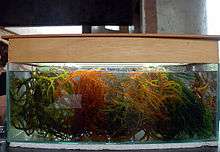Kappaphycus alvarezii
Kappaphycus alvarezii, the elkhorn sea moss, is a species of red algae. It is one of the most important commercial sources of carrageenans, a family of gel-forming, viscosifying polysaccharides. Farming methods affect the character of the carrageenan that can be extracted from the seaweed.
| Kappaphycus alvarezii | |
|---|---|
 | |
| Scientific classification | |
| (unranked): | Archaeplastida |
| Division: | Rhodophyta |
| Class: | Florideophyceae |
| Order: | Gigartinales |
| Family: | Solieriaceae |
| Genus: | Kappaphycus |
| Species: | K. alvarezii |
| Binomial name | |
| Kappaphycus alvarezii (Doty) Doty ex Silva | |
This alga grows to two meters long and is green or yellow in color.[1] It is very fast-growing, known to double its biomass in 15 days.[1]
Different carrageenan types differ in composition and conformation, resulting in a wide range of rheological and functional properties. Carrageenans are used in a variety of commercial applications as gelling, thickening, and stabilizing agents, especially in food products such as frozen desserts, chocolate milk, cottage cheese, whipped cream, instant products, yogurt, jellies, pet foods, and sauces. Aside from these functions, carrageenans are used in pharmaceutical formulations, cosmetics, and industrial applications such as mining.[2] Carrageenan is extracted from this seaweed in two ways. In native extraction, the seaweed is made into an aqueous solution, and the residue is filtered, leaving nearly pure carrageenan. The alkaline-modified method is less expensive and easier. The seaweed is mixed in an alkali solution, leaving a mixture of carrageenan and cellulose that can be sold as semirefined carrageenan. K. alvarezii is affected by ice-ice, a disease that severely reduces its yield.
This alga is an introduced species and a noxious aquatic weed in Hawaii.[1]
References
- Marine Algae of Hawaii
- Hayashi, L., et al. (2007). Growth rate and carrageenan analyses in four strains of Kappaphycus alvarezii (Rhodophyta, Gigartinales) farmed in the subtropical water of SaoPaulostate,Brazil. J Appl Phycol. 19: 393-99.
External links
- Kappaphycus alvarezii. AlgaeBase.
- rong sun (Vietnamese name: Rong sun).
- http://www.irishmoss.eu